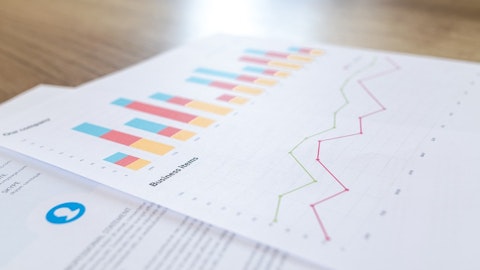Eric Ashleman: Yes. I mean, it is interesting. I think the industrial system is still performing at a pretty high level. I mean the day rates that we’re talking about here, that flatness that I described in those canary levels, that’s a pretty healthy business that suggests people are working, factories are producing things and putting it to work. Certainly around it, though, discussions around longer-term commitments or things that are going to happen in the spring of next year, I mean, they’re just — they’re harder conversations to have because of all the uncertainty that people are feeling, pick anything from the higher interest rate position on the increasing geopolitical risk that’s out there, consequences of a major election in the U.S. next year, right?
You can see to see a lot of people on the one side continuing to kind of forecast on the things that are happening day to day, but kind of backing up with a wait-and-see approach at a higher level just because of uncertainties for anything that sort of passed the horizon.
Mike Halloran: Yes, makes sense. One quick follow-up, a clarification for Allison. Did you say that $0.05 shifted from 4Q into 3Q? I just want to clarify what that statement was, Allison.
Allison Lausas: That’s correct, Mike. So we can find more aggressive backlog pull down in third quarter. So it’s just a shift of timing within the back half of the year.
Operator: Our next question comes from Nathan Jones with Stifel.
Nathan Jones: I guess I’ll ask a question about the order rates here. The order rates in FMT, the actual dollars aboard is a bit lower in 3Q than in 2Q and orders in HST in 3Q a bit lower than 2Q. Is it possible for you to kind of separate out what you think is a decline in customer backlogs versus what actual decline in end market demand? And I guess what I’m trying to get at here is, if you’re talking about inventory correction having happened and we moved to selling more towards sell-through, wouldn’t that imply then that you should see sequential improvement in the actual dollars of orders in both of those businesses as we move into the fourth quarter?
Eric Ashleman: Yes. But well, look, again, I put a lot of weight on the predictive abilities of those early indicator businesses that we have to talk a lot about sort of day-to-day, how the system is operating. So I think that — again, that stability means a lot. In this environment, order patterns do change a little bit. Remember, an earlier comment I had there for Mike, I mean I think you’re seeing people moving to shorter increments of order patterns. They know now companies like — I mean, certainly, IDEX, we can deliver with faster replenishment. Our customer satisfaction metrics are really good. So if you feel any uncertainty, you don’t have to give us nearly the same kind of visibility in your order requirements that you had to 2 quarters ago or a year ago.
So I think you do see a piece of that, that changes in the order profiling, more of a order it as you go. And so — again, we ate into some pretty aggressive backlog along the way. At any time lead times keep coming down, I mean that does tend to influence order patterns for folks on the other side. So I think it’s things like that playing out, by and large, around a pretty stable base, especially on the industrial side. To me, says, I think this is a stable environment, but one that’s looking for the next catalyst.
Nathan Jones: I guess my follow-up question, I know you guys don’t do a lot of large projects, but you have stuff that goes into larger projects. And I think investors have been concerned that rising interest rates business in inflation, are changing the dynamics, changing the ROI for customers on those investments. Can you talk about what you’re seeing on customers’ willingness to let out these larger capital projects? I know historically, you’ve seen people hesitate in these kinds of environments. So just any color you can give us on what you’re seeing there.
Eric Ashleman: Yes. Well, that’s probably a piece of the answer to your last question as well. I mean the certainty around projects like that is not very good. And you’ve got some people that are — they’re still talking about them, but they start to move that time horizon. We’re getting closer to 2024 like a magnet. And so it becomes a reference point and a point in the calendar where people are pointing to when things might come to fruition in that side of it. Again, contextually for us, that’s not all of our businesses, but we’ll see it as part of a planned expansion commitment or something like that for food or something related to infrastructure. So those kind of discrete things that require a lot of capital will come together, a lot of planning. I think there is a lot more uncertainty around them. And it’s — instead, it’s kind of running the current system faster and a little bit longer before you rebuild it due to that same level of uncertainty.
Operator: Our next question comes from Allison Poliniak with Wells Fargo.
Allison Poliniak: So Eric, I just want to go back to HST. One of the things IDEX has been known for is investing through the cycle. Could you maybe talk to the new product development cycle in analytical instrumentation, life sciences? Or maybe even how you’re thinking about that investment? Has that slowed at all? Should we expect maybe a slower organic coming out of this? Just any thoughts there.
Eric Ashleman: Well, I’m actually glad you mentioned that because, in many ways, at ground level in those businesses, you kind of see two realities sitting side by side, and they’re actually quite different. One is the near-term reactive reality of what’s happened over here in the last year, where order levels are and what daily requirements are, lots of cost containment and being super crisp around productivity and just getting the product out. But even at the customer level, I mean, I think you see that entire world is spending a lot of time thinking through, okay, what do we need to do to innovate to get ahead of the game in the next cycle? Because I can’t find anybody that doesn’t see that there’s going to be something more positive coming here.
The same mega trends that have been driving that sector forever are not very far out ahead of us and will occur again. But when they do, we’re seeing at the customer level and within our business is a real step-up in terms of innovative steps to get after it. I was talking to Terra Teresa, who runs our businesses there, and she’s describing some of the projects that we’re working on in conjunction with really significant customers. And it’s some of the highest degrees of innovation jumps that I’ve frankly, seen in the last few years. So I think there’s actually a very purposeful, collaborative arrangement here to talk about where this industry is going to go. And as it comes out, this is one of the reasons I think we try to stay as fast nimble as we can, so we can put capital and resources to those best opportunities and, frankly, overfeed them in times like this.
So you’ve actually called it exactly how we see it at a ground level.
Allison Poliniak: That’s great. That’s good color. And then a small divestiture, as you think of the portfolio today, obviously, a very unusual cycle here. Was this sort of just a one-off? Or is this something that you think we might see more of as we go forward here? Just any thoughts.



